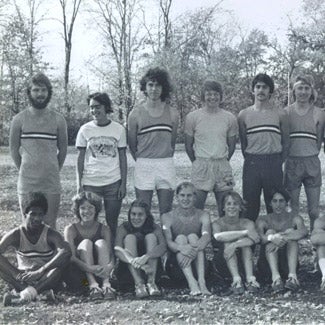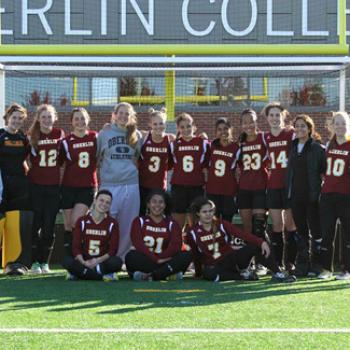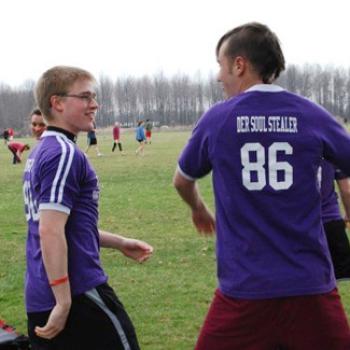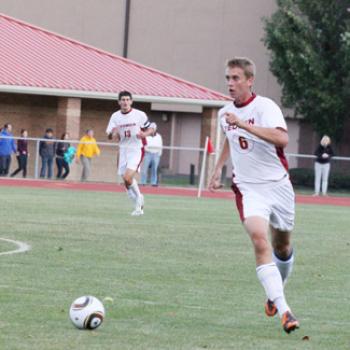On being one of the first female runners
Carla White Freyvogel ’79
“Running became a political statement for me... while other women made statements in class, delivering heart-pounding lectures, papers, and demonstrations, I put on my shoes and ran with the men.”

My first year of college, the fall of 1975, was disappointing. I anticipated that Oberlin, the first school to educate women in a co-educational environment, would have a women’s cross country team. Not a chance. What Oberlin did have though, was Coach Dick Michaels. Despite being a pretty traditional guy, Coach Michaels saw absolutely no reason why he could not coach and race a co-ed team. He was to find out that this was problematic; he had his share of face-offs with other coaches in the Conference who wanted us off the courses. But he defended us, the three women on the team, always. And he kept us not just on the team, but made us a part of the team.
My memories of that time are of being a scruffy, dopey freshman, and being towed along on these 10 mile runs with very zippy men. Having been instructed by Coach Michaels to stay together, the men did what they could to get a workout in: tossing baseballs and apples, sprinting to catch them, and basically doing a fartlek workout while I ran slow (very slow) and steady.
My other running memories involve other training partners. There was Marty Dugan ’73, who was back at Oberlin, working in Admissions. There was Dick Levin, the Biology professor, who was so wonderful that I actually declared Biology as my major just to hang out in his office. (Later, I changed to Art History, my true calling.) I also ran with an assortment of people from town: Tom Dawson, the City Manager, and Marshall Whitehead, a notorious ladies man.
Running gave me a social network beyond other college students. Through Tom and Marshall, I became invested in the city of Oberlin. I spent two summers working for the Recreation Department, supervising an open gym for school aged children. But, due to my reputation as fitness fanatic, I was convinced to teach an exercise class.
Knowing little about general exercises, I would have my class throw their arms around and do a few perfunctory stretches. Then I would take them out on the roads of Oberlin’s neighborhoods to run. It was a good thing this was before waivers, because this was pretty risky business. My class was entirely middle-aged women, all quite sedentary and overweight. I led them with abandon, pushing their heart rates up, helping them to shed pounds and get fit. They would string out on the sidewalks, doing a combination of jogging, shuffling, and walking as I would cheerfully run around them offering support. They took me in as a young friend and confidant. They invited me to cookouts and graduations, welcoming me into a broader Oberlin community.
Running also gave me a way to physically embrace Oberlin. It was that basic experience of just being outside. I can still feel those days in my bones — the clear light of summer and early fall, the slickness of damp leaves in November, the crazy cold of January and February. We did all this before Gortex jackets, Under Armour Cold Gear, and indoor tracks. Did we have shoes? I can’t remember. I do remember one day during Winter Term that it warmed up to 23 degrees — my roommate and I were so excited we ran in shorts and tee shirts!
Running gave me distinction on a campus of very distinctive and distinguished people. It was mine. As one of a very few female runners, it was almost mine alone. Because it was Oberlin and because it was the ’70s, running became a political statement for me. It was a time in which women’s sports were few and far between. It was a time during which the concept of wellness and fitness had little popular support. It was a time when people yelled at us to get off the road, to go home and cook dinner. Once, I remember someone throwing a little cherry bomb at us. While other women made statements in class, delivering heart-pounding lectures, papers, and demonstrations, I just put on my shoes and ran with the men.
My daughter came to Oberlin in 2005. As a lacrosse player, her training involved its share of “4 mile loops.” After taking 30 years off, I started the climb back to fitness until I could finally join her. After we mastered the 4 mile loop, we added the reservoir and explored the bike path. We admired architecture on Morgan and Forest Streets. We got up early and wore layers of clothes in the fall, we ran races in the town, and we bounded along on the new woodchip trails.
Running changed at Oberlin. There were women’s cross country teams, there were women’s track teams, there were specialized distance coaches. Then, there was Ray Appenheimer. From the sidelines, I have watched enviously as he and Jason Hudson patiently and thoughtfully brought in smart, interesting young women who just so happened to be great runners. Together, Ray and Jason made them better runners. The teams are large. They are good! They win!
To bring it full circle, my daughter took a running class with Ray one semester. I told her that was like having Bruce Springsteen teach beginning guitar. One day, I was visiting and had a chance to “audit” the class. He was having the class do a series of repeat 400s on the indoor track. I got to join them for the first 200 yards of each repeat. It was a real high point for me in my return to running. On that day, for a bunch of 200s, I got to be an Oberlin athlete again.
Tags:
You may also like

On finding friends on the field hockey team
“A camaraderie developed—probably born out of undergoing the rigors of preseason together—which blossomed into close friendships over the course of the season.”
Aditi Banerjee ’17

On the universal language on soccer
“Intramural soccer has given me a new knowledge base... I’d be lying if I said that my current appreciation for soccer hadn’t solidified my choice of pursuing Hispanic studies at Oberlin.”
Max Hovey ’13

On being a part of the Oberlin College men’s soccer team
“We call it OC Love. We don’t play for ourselves, we play for each other. I am honored to stand side by side with every one of those guys.”
Alen Cisija ’12